Use of Cookies
Our website uses cookies to facilitate and improve your online experience.
There are "Two Sotoshus" in the USA. One is for Japanese immigrants. The other is for American converts from their own religions such as Christianity or Judaism.
Sotoshu's missionary activity there began by serving Japanese Americans through performing funerals and other rituals similar to the traditional ones done in Japan. Zenshu-ji in Los Angeles was founded in 1922 as the first Soto Zen Buddhist temple in North America for the Japanese-American community. The history had to wait for about forty more years to see Soto Zen being practiced by non-Japanese Americans.
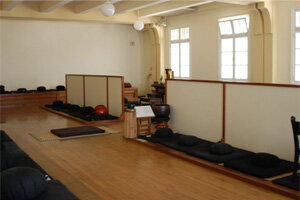 In 1959 Shunryu Suzuki (1904-1971) roshi realized his wish to go to the USA as a Sotoshu missionary. He took up his appointed post as a sixth resident priest at Soko-ji temple located in the part of San Francisco known as Japantown. This temple was founded in 1934 by the community of Japanese-Americans. But soon after his arrival young Americans started coming to the temple to practice zazen with him.
In 1959 Shunryu Suzuki (1904-1971) roshi realized his wish to go to the USA as a Sotoshu missionary. He took up his appointed post as a sixth resident priest at Soko-ji temple located in the part of San Francisco known as Japantown. This temple was founded in 1934 by the community of Japanese-Americans. But soon after his arrival young Americans started coming to the temple to practice zazen with him.
... They sat facing the wall, all lights out except the candle on the altar. Sensei (Suzuki roshi) walks around with a big stick-quite a few get good whacks. ... boys that look like beatniks with beards, sweat shirts, and some with sandals, but I must say they seem sincere. ...
(Rick Fields, How the Swan came to the Lake)
Thus a community of American Zen practitioners was formed around Suzuki roshi and before long they founded San Francisco Zen Center (SFZC) separate from Soko-ji in 1962.
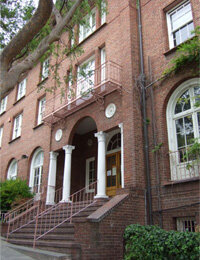 The number of the people who practice at SFZC dramatically increased. Suzuki roshi felt the necessity of having a place where his students could stay away from the city life and have an intensive Zen training. After a major fund-raising effort they could purchase the land in Los Padres National Forest, named Tassajara Hot Springs. SFZC established there Tassajara Zen Mountain Center ("Zen Mind Temple" or Zenshinji) in 1966. It was the first Zen Buddhist monastery built in the United States.
The number of the people who practice at SFZC dramatically increased. Suzuki roshi felt the necessity of having a place where his students could stay away from the city life and have an intensive Zen training. After a major fund-raising effort they could purchase the land in Los Padres National Forest, named Tassajara Hot Springs. SFZC established there Tassajara Zen Mountain Center ("Zen Mind Temple" or Zenshinji) in 1966. It was the first Zen Buddhist monastery built in the United States.
In 1969 Suzuki roshi resigned his position as a priest at Soko-ji to focus on teaching Zen to Americans. He moved to a large residential building on Page Street, which became known as the City Center.
Suzuki roshi died of cancer on December 4, 1971. He was 67 years old. Although he stayed in the United States for only 12 years, he had done a great work to establish Soto Zen in America. It is very interesting to think about why this old Japanese Buddhist priest who were born before World War II attracted so many young Americans who were born after the war during turbulent sixties. It is for sure due to his magnetic personality but his style of teaching which emphasized a simple practice of "just sitting" with a "beginner's mind" and daily living based on Zen principles was also very much appealing to them.
In 1972 SFZC founded Green Dragon Temple (Soryu-ji) at Green Gulch Farm in Marin County, just north of San Francisco. About ten years after its formation San Francisco Zen Center had grown up to be one of the largest and the most active Buddhist sangha in the West.
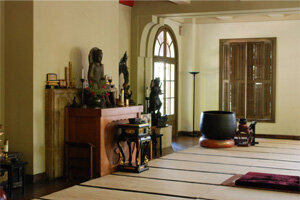 Today SFZC consists of three main practice centers, City Center (Beginner's Mind Temple, or Hosshinji), Green Gulch Farm, and Tassajara Zen Mountain Center and its associated Zen centers. These three Centers offer, in common, daily zazen, intensive retreats, study classes, dharma lectures, and various workshops. But each of them has its own character and the environment. Besides the traditional Zen practices, SFZC has many other "engaged Buddhist", or "community-building" activities, such as Family Activities, Coming of Age Groups, Meditation in Recovery, and Outreach Activities.
Today SFZC consists of three main practice centers, City Center (Beginner's Mind Temple, or Hosshinji), Green Gulch Farm, and Tassajara Zen Mountain Center and its associated Zen centers. These three Centers offer, in common, daily zazen, intensive retreats, study classes, dharma lectures, and various workshops. But each of them has its own character and the environment. Besides the traditional Zen practices, SFZC has many other "engaged Buddhist", or "community-building" activities, such as Family Activities, Coming of Age Groups, Meditation in Recovery, and Outreach Activities.
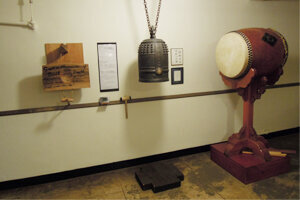 The day at Hosshinji starts with zazen.
The day at Hosshinji starts with zazen.
At 5:25, morning zazen begins with the sound of three strikes on the zazen bell. City Center Hosshinji residents wake up before this bell and get ready to enter the zazen hall in the basement for zazen. Non-residents can also join morning zazen, so usually a number of people sit together in the morning in the zazen hall.
After sitting for half an hour, the sound of two strikes on the zazen bell indicates the end of the first sitting period. Everyone stands up and begins kinhin - walking Zen. When kinhin ends, the second period of zazen begins.
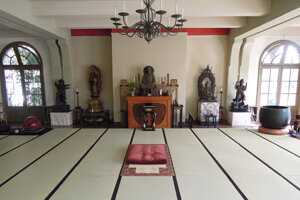 At the end of the second zazen period, participants move up to the dharma hall on the first floor. The dharma hall is a place for ceremony and dharma talks. There they perform morning service, offering sutra chanting to the Buddha and the ancestral teachers. Participants chant the Sotoshu sutras translated into English. Usually in Japan at the beginning of the ceremony, all the participants make three prostrations to the Buddha. But here at Hosshinji, they make nine prostrations. This is their tradition from Shunryu Suzuki Roshi, the founder of San Francisco Zen Center.
At the end of the second zazen period, participants move up to the dharma hall on the first floor. The dharma hall is a place for ceremony and dharma talks. There they perform morning service, offering sutra chanting to the Buddha and the ancestral teachers. Participants chant the Sotoshu sutras translated into English. Usually in Japan at the beginning of the ceremony, all the participants make three prostrations to the Buddha. But here at Hosshinji, they make nine prostrations. This is their tradition from Shunryu Suzuki Roshi, the founder of San Francisco Zen Center.
After morning service, it is time for cleaning. The person in charge gives instructions to each person and they clean the dharma hall, zazen hall, dining room, corridor, toilets and all other areas.
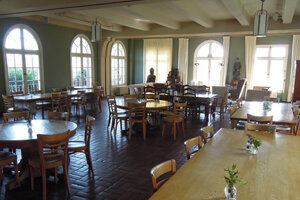 Next comes breakfast. At the beginning of zazen, kitchen workers, called tenzos, begin cooking a vegetarian meal for everyone. Diners observe silence during meal time, mindfully eating what is there in front of them. Occasionally on Saturday morning, participants eat breakfast using oryoki. Oryoki is a set of bowls used by Buddhist monks from the time of Shakyamuni Buddha. There are strict manners associated with eating in this way. Eating in silence is derived from this traditional manner.
Next comes breakfast. At the beginning of zazen, kitchen workers, called tenzos, begin cooking a vegetarian meal for everyone. Diners observe silence during meal time, mindfully eating what is there in front of them. Occasionally on Saturday morning, participants eat breakfast using oryoki. Oryoki is a set of bowls used by Buddhist monks from the time of Shakyamuni Buddha. There are strict manners associated with eating in this way. Eating in silence is derived from this traditional manner.
After breakfast, at 9:00 a.m., people start work practice time. Some residents at the City Center have their own jobs outside the Center and they leave for their workplaces. The rest engage in their assigned duties - kitchen work, cleaning, garden work, office work, and so forth. If you are visiting the Center as a guest student, you probably will be assigned to do cleaning or kitchen work. Lunch is at noon and work continues until around 3:00 p.m.
Every Thursday there is a tea time for guest students. They have tea with monks at the City Center, ask questions and enjoy informal conversation.
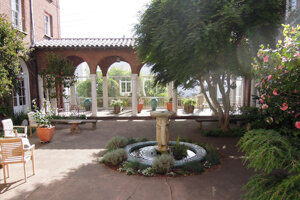 At 5:40 p.m., it is time for evening zazen. As in the morning, after zazen there is evening service and a meal. After supper, there is free time.
At 5:40 p.m., it is time for evening zazen. As in the morning, after zazen there is evening service and a meal. After supper, there is free time.
There is a Dharma talk every Wednesday at 7:30 p.m. Many people from outside the City Center come to join the residents. There are many other activities in addition to Wednesday dharma talks, for example, Meditation in Recovery and Young Urban Zen. These are conducted by City Center priests. There are also classes for newer students – a zazen instruction class and a discussion group with tea.
At 9:00 p.m., all the activities at the City Center end. That is the closing of the day.
Hosshinji, or the City Center is located in the city of San Francisco. It has a residential program. Unlike a rural Zen center, at the City Center residents can have outside work and follow the morning and evening parts of the schedule. So it is possible to do both a job and Zen practice.